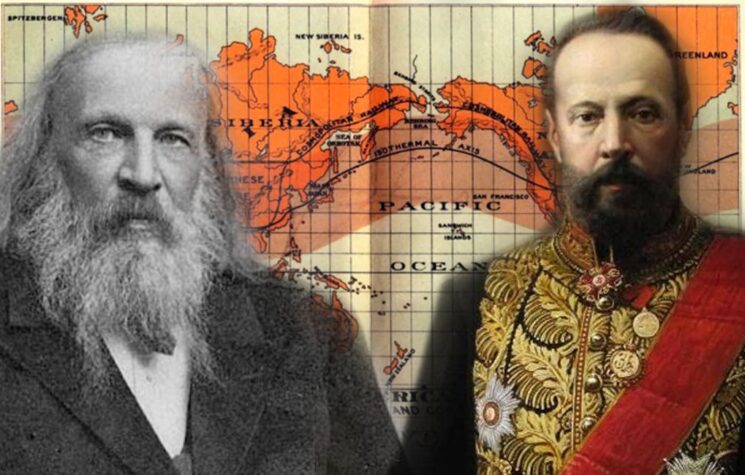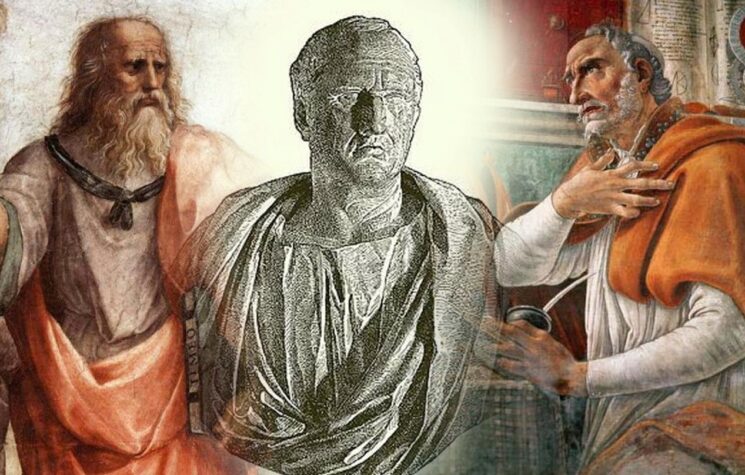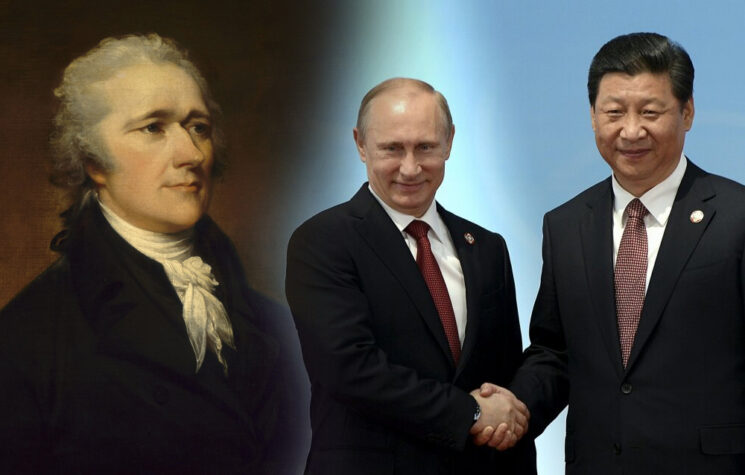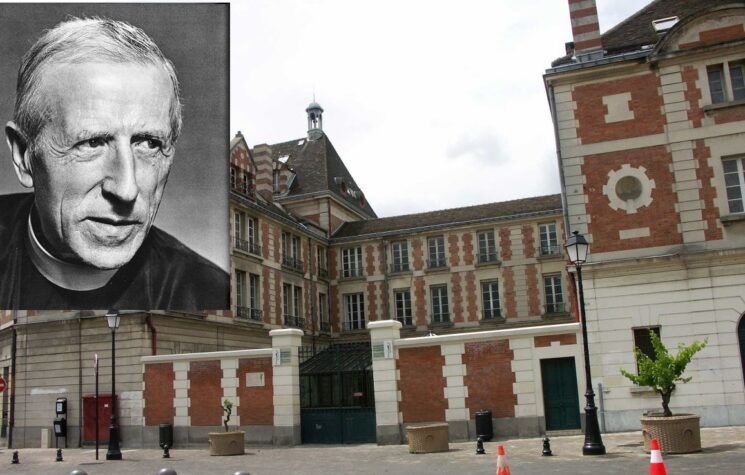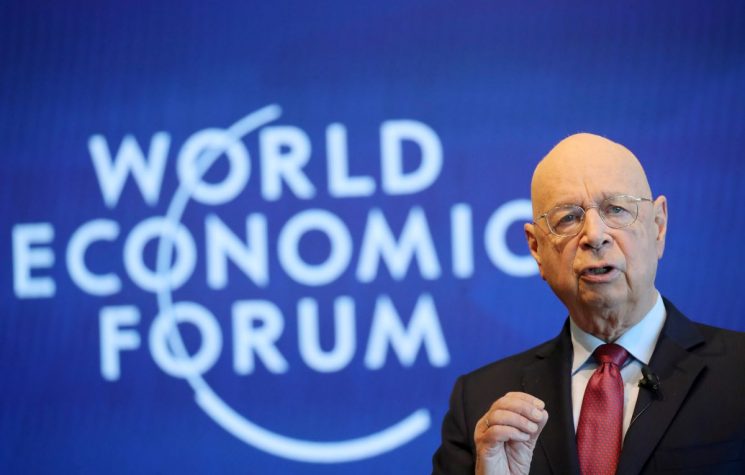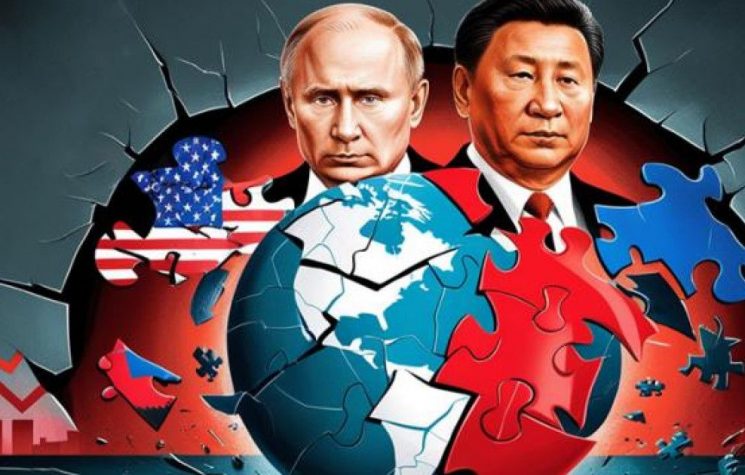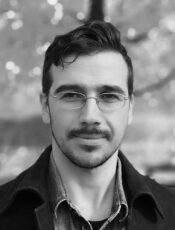Amidst the war and blood, Vernadsky continued to work and write, never losing hold of the age of reason (the age of the noosphere) which he saw inevitably awakening in the future.
At a recent World Government forum in Dubai, WEF president and Dr Evil lookalike Klaus Schwab made a big deal about systemic changes that were currently underway across the globe and despite the dangers posed by the breakdown, Klaus believed that great opportunities were to be found for those hungry to shape a new system. In his speech Klaus said:
“History is truly at a turning point. We do not yet know the full extent and the systemic and structural changes which will happen. However, we do know that global energy systems, food systems, and supply chains will be deeply affected.”
Meanwhile in Jackson Hole, Wyoming, a central bankers conference is underway where discussion of the systemic crisis and new system of central banking digital currencies and “green finance” will pave the way to a supposed green New Deal economic recovery.
At the other side of the iron curtain, a recent forum took titled ‘Strong Ideas for a New Time, where President Putin also spoke of the new systemic changes that are shaping all facets of life contrasting the multipolar outlook with the obsession on an “international rules based order” animating the west. In his speech Putin said:
“These enormous changes are irreversible, of course. National and global processes are underway to develop the fundamentals and principles of a harmonious, fairer and more community-focused and safe world order as an alternative to the existing world order, or the unipolar world order in which we lived, and which, because of its nature, is definitely becoming a brake on the development of our civilisation.”
No matter where one looks within those discussions occurring in the corridors of power in Eurasia or the western unipolar bloc, the idea that a new system will replace the current order is an unquestioned reality.
But as much as similar words may be found to overlap, the core concepts associated of the two systems (unipolar vs multipolar) are in fact diametrically opposed. Unless one takes a bit of time to appreciate not only the nature of closed system thinking animating western technocrats or the opposing healthier paradigm of open system thinking animating the grand strategic planning of the leaders of the Eurasian partnership, then it were impossible to properly navigate through our current storm.
While both paradigms feature concepts of a “natural order”, one assumes a system whose natural state is unipolar, demands vast population reduction, decarbonization, energy use contraction, and food production reduction. The other system, however is profoundly open, multipolar and premised on the idea of ongoing scientific and technological growth.
The Nature of Systems Analysis and You
The concept of “systems” is integral to all human mentation whether we know it or not, and has occupied the minds of great thinkers for thousands of years.
Although a mind absorbed by a naïve belief in sensory impressions will often assume the existence of self evident “things” in nature floating in empty space without due regard for contexts known and unknown shaping said object of sense impression, the reality is that no simple “thing” exists as an island unto itself.
No atom on Mendeleyev’s periodic table can be said to have any self-contained existence outside of the whole spectrum of elements and isotopes which shape its behavior, purpose and nature within a whole.
Similarly, no cell exists outside of the living system which shapes its behavior and whose behavior it in turn shapes.
No single plant or species of plant life exists outside of a biosphere which itself is shaped by long evolutionary forces with each plant playing a direct role in supporting and in turn being supported by, the entire bio-geochemical system in which it exists.
Just like an element, or cell, this biospheric activity is itself shaped by atomic, astrophysical and even galactic forces which carry both material and energetic properties stretching to the largest expanse of our galaxy’s field of influence and the broader cluster of galaxies which our modest Milky Way is but a part. Of these forces in the very large, and very small, our knowledge is scant, although increasing with small leaps of progress.
Each system one chooses to direct the mind’s attention to- from the lithosphere, biosphere, body of an organism, or even of a galaxy, certain fundamental invariant characteristics can be observed.

Four Properties of Open Systems
1) Each system can be understood as both a “One”, a “Many” and an “infinite”… simultaneously. In this way, the Aristotelian modes of logic which assert a priori that “something must be A or Not A, but never both A and Not A” break down. Instead, the preferable mode of reasoning demonstrated by Plato in the Philebus dialogue proves infinitely more useful at analysing the world as it actually is. (1)
2) A system is either understood as organized by reason or arbitrariness. If arbitrary, then we might as well stop trying to wrap the mind (reason) around the unreasonable, and give up immediately. Since we are continuing our journey, I am assuming that you agree with me that reason governs natural systems. If this be so, then the parts of each system under analysis must be found to demonstrate both purpose and design within the whole of which they are parts. This takes us directly into an awareness of the coherence that must exist between the subjective properties of creative thought and the discoverable properties of the objective universe.
3) Any broader system shaping smaller systems cannot be bounded by the exact same properties and principles. In this sense, we find that the daily cycles of planetary rotation do not find 100% reconciliation in the higher geometries of annual revolutions of planets around the sun, nor do the sun’s revolution around the galactic center find an exact commensurability with the lower cycles of the solar system. There will of course be common traits expressed throughout lower and higher cycles, but there will also be unique properties with each newly discovered cycle as well. Kurt Gödel’s 1931 refutation of the Russell-Whitehead Principia Mathematica provides one of many interesting proofs of this fact. Leibniz’s dispute with Locke, Descartes and Newton provide additional fuel to this line of Platonic reasoning.
4) Each system under investigation must be understood to be more than its sum of parts. The reductionist biologist attempting to isolate the life principle in a rabbit finds themselves confused by the fact that the dead rabbit is not quantifiably different from the living rabbit- being made up of the same molecules and gases. Yet there is something beyond the simple “material expression” of living matter which said reductionist cannot fathom which again is where the Aristotelian logic of materialists will tend to break down.
The principal dispute which has shaped the entirety of world history is based on the two-fold issue of mind’s relationship to nature and its corollary: are systems fundamentally open or closed?
The Case of Vladimir Vernadsky’s Understanding of open systems
A great biogeochemist who shaped in many ways the flow of some of the most exciting leaps in creative scientific progress in the first half of the 20th century was named Vladimir Ivanovich Vernadsky (1863-1945). Throughout his career, Vernadsky served as a leading light in Russian science, acting both as founder and first President of the Ukrainian Academy of Science and leader of the Russian Academy of Science. Vernadsky founded the Radium Institute of Russia after collaborating extensively with Madame Marie Curie in France, oversaw the development of nuclear science in Russia, was among the earliest proponents for nuclear power generation and as such, is considered the father of Russian nuclear science.
Throughout his years of productive scientific work, Vernadsky internalized the methods outlined by his mentor Dimitry Mendeleyev and applied his creative powers to finding unifying principles that shape the behavior of systems not only as they are “found” in space, but also in time.
While not ignoring the forests for the trees, Vernadsky demonstrated an extreme quality of rigor while mastering the mechanics of the fields of biology, geology and chemistry pushing himself to the limits of humanity’s knowledge of all three fields. Recognizing that needed discoveries in any one domain required moving out of narrow specializations into the other two domains of knowledge, Vernadsky pioneered a new field of research called “Biogeochemistry” by the early 1920s.
Throughout his work on Geochemistry (1924), The Biosphere (1926), On the Principles of Biogeochemistry (1938), and The States of Physical Space (1938), Vernadsky made a point to locate as many unifying principles of nature as possible insofar as they could be found by looking holistically upon the behavior of living matter as distinct from non-living matter.
Several of these principles which he dubbed “empirical generalizations” can be here listed:
1) The Huygen’s Principle. Although calcium, carbon, nitrogen etc are expressions of non-living matter, their behavior, purpose and form when animated by life are entirely different due to the incommensurable difference of life and non-living domains. Vernadksy wrote of this principle in 1943: “[Christian] Huygens established the scientific generalization that “life is a cosmic phenomenon, in some way sharply distinct from nonliving matter.” I recently named this generalization “the Huygens principle”.
2) The non-existence of abiogenesis. Just as existence cannot be said with good reason to arise from non-existence, the impossibility for life to arise from non-life was explored by Louis Pasteur in the 19th century and was embraced by Vernadsky as a foundational empirical generalization. Vernadsky writes: “The connection between the living and the inert substance of the biosphere is indissoluble and material within the geological time… Abiogenesis is not known in any form of its manifestation. Practically, the naturalist cannot overlook in his work this empirically precise deduction from a scientific observation of nature, even if he does not agree with it due to his religious or philosophically religious premises.”
3) The Golden Section. Five-fold symmetries and the golden section which are inherently united in the the construction of the pentagon, permeate living systems both in form as well as in population growth patterns in time. These attributes are nearly entirely absent from the non-living world of abiotic matter and was first explored Leonardo Da Vinci in the late 15th Comparing the configuration and behavior of atoms contained in non-living crystals compared to living organisms, Vernadsky writes: “Living organisms exhibit five-fold or higher than sixfold axes of symmetry. This indicates that we are not dealing here with the symmetry, or the atomic structure, of a homogeneous solid. The homogeneity of internal structure, which is so characteristic of crystals, is absent here. The inside of a living organism is distinctly heterogeneous, its atoms being in continuous motion, never returning to the same points where they were, unlike crystals, where the atoms do not shift for billions of years, unless external forces cause that to happen.”

4) Light Rotation. Life rotates planes of polarized light which does not occur when the same polarised light passes through liquid solutions devoid of any presence of organic material. Vernadsky writes: “All proteins exhibit a left rotation of the plane of light, both in animals and in plants. This means that, in the complex matter of living bodies, only left isomers in protein bodies—the principle component of protoplasm—are stable. Right isomers are absent”

5) Handedness/Chirality. This property, investigated deeply by the young Louis Pasteur in the 1850s, extends into isomers/chirality of molecular biology that was beginning to open up new doors of discovery in Vernadsky’s lifetime. Just as living systems demonstrate “handedness” regarding harmonic disequilibrium preferring left handed spirals in sea shells over the inverse, so too do molecules with identical atoms and bonding properties demonstrate different qualitative properties when formed in the mirror image of themselves. Here again the logic of an Aristotelian (or other syllogistic machine thinking) breaks down. Vernadsky wrote of this early discovery saying: “The molecular dissymmetry, discovered by Pasteur, showed, that the presence of living matter is reflected in the chemical formula, including in solutions, and that right- and left-handed atomic structures are found to be non-equivalent in chemical reactions. They are chemically distinct in living matter, but chemically identical in inert chemical media”

A simple example of chiral molecules of a generic amino acid. Among the many interesting examples of chiral molecules (enantiomers) is carvone which results in a spearmint aroma in one configuration and caraway in its mirror image
6) The Ubiquity of Life. In Vernadsky’s analysis, the tension found in the biosphere which is connected to the rise of new living properties among species is NOT located in scarcity or vacuum as British Darwinians had asserted for decades, but rather in a positive yearning of life to express its potential to the fullest possible measure, and in so doing, leap beyond the limits of nature through the advent of new biological “technologies”. This yearning of each species towards expressing itself to the fullest was seen by Vernadsky as a colonization process, and the new “technologies” which nature generated (whether the chlorophyll molecule that allowed early life to begin using sunlight to increase its power to thrive and create) giving living matter the attribute of moving from lower to higher states of organization and complexity. Vernadsky writes: “The creation resulting from this evolution of new living forms, adapts itself to new forms of existence, augments the ubiquity of life, and enlarges its domain. Life penetrates, thus, the regions of the biosphere where it had not earlier had access.”
7) Top Down Systemic Change as Primary. Vernadsky emphasizes that each upshift from one lower system to a higher system in evolutionary time, occurs as a change within the system as a whole and never within the bottom-up accumulation of units of particular species or individuals fighting for survival in a closed system of diminishing returns as we find in the Darwinist worldview.
8) Increasing Biogeochemical energy. From a material standpoint, each advanced new species and organism processes molecules and atoms from the ambient environment in a process akin to that of a whirlpool. Unlike the whirlpool however, each living organism does not merely move the elements through it unchanged, but rather change the molecular and even isotopic properties of elements via acts of respiration, nutrition, and reproduction. From an energetic standpoint, organisms tended to advance in such a manner that the metabolic power (the ratio of matter converted into energy) in the form of nutrition increased as greater means of doing work was achieved. The orientation of this entire process is not a mathematical homeostasis as a closed system interpretation of nature must presume, but rather an increase of free energy such that a system as a whole is “tuned” to generate not only enough energy to sustain itself, but increased free energy to feed back into the system that allows for the support of newer, more productive and diverse species. Vernadsky writes in his Problems of Biogeochemistry II: “The basic distinctive feature of biogeochemical energy is clearly and forcefully demonstrated in the increase of the free energy of the biosphere over the course of geological time”
9) Biogenic Migration of Atoms: As a corollary of point 8), advanced living systems tend to increase the throughput of the biogenic migration of atoms much like more increasingly efficient whirlpools moving carbon, calcium, potassium and other elements more forcefully through organisms and back into the biosphere resulting in long term changes in the entire biosphere and even geology, atmosphere and even ozone layer of the planet as a whole. Vernadsky states: “Biogenic migration not only depends on the quantity of atoms caught by it at every moment in the biosphere, but also on the rapidity of their movement, the number of atoms passing through living matter in a unit of time, or on the displacement, in this same unit of time, provoked by an intervention of a technological order by living matter within the ambient environment… The biogenic migration of chemical elements in the biosphere tends towards its most complete manifestation.”
10) Cephalization. Taking aim at the Darwinian interpretation of natural selection which rejects any notion of directionality in the flow of evolution, Vernadksy instead embraced the empirical generalizations of Dana and Joseph Le Conte. To these two men, Vernadsky wrote: “The younger contemporaries of Darwin, J[ames] D[wight] Dana (1813-1895) and Joseph Le Conte (1823-1901), both great American geologists (and Dana, a mineralogist and biologist as well) expounded, even prior to 1859, the empirical generalization that the evolution of living matter is proceeding in a definite direction. This phenomenon was called by Dana “cephalization,” and by Le Conte the “Psychozoic era.”
In Dana’s work, “cephalization” represented the tendency of life to organize itself increasingly around an ever more centralized nervous systems which provided an important guide post for the flow of living systems in evolutionary time while in Le Conte, the notion of the “psychozoic era” defined the age of mankind that teleologically directed the flow of changes in all preceding ages in evolutionary time.
Beyond the atomic and molecular properties of forces and matter which are shaped by either life or its absence. Vernadsky was always careful to distinguish the concepts of “living matter” as opposed to “life” which he understood to be a principle of space time itself writing in 1943: “Instead of the concept of ‘life,’ I introduced that of ‘living matter,’ which now seems to be firmly established in science. ‘Living matter’ is the totality of living organisms.” Vernadsky added that life must be understood as “a planetary phenomenon that is cosmic in nature.”

The Noosphere
Living matter was merely one particular expression of life in Vernadsky’s mind, and all the same can be said of the Noosphere (properties of mind) which we can examine through forms of noetic fossils in the form of matter shaped by human thought.
Examples of the latter did not only include tools, or infrastructure, but also species of domestic fruits, vegetation, and animals whose existence was only made possible by the slow selective breeding by human beings across generations. With each leap of mind’s power over nature, discovery and transmission of concepts from one mind to other minds is vital. Among the earliest such discoveries that give humanity a power over nature, Vernadsky zeroes in on the discovery and use of fire:
“The discovery of fire presents the first instance in which a living organism takes possession of, and masters, one of the forces of nature. Undoubtedly this discovery lies, as we now see, at the foundation of mankind’s subsequent future increase and of our present powers.”
While these noetic fossils can be seen, measured and weighed, they are but shadows of something more fundamentally causal. It is this deeper cause which cannot be seen, tasted, heard or felt by the senses and yet which is necessarily existent. The transcendental “light” of mind’s fruitful activity which casts the “shadows” of material changes in the lithosphere, biosphere and human society itself brings us into a science of mind as a geological force and cause of all changes. Vernadsky writes: “The noösphere is a new geological phenomenon on our planet. In it, for the first time, man becomes a large-scale geological force.”
It is here that Vernadsky reveals that he recognizes in creative mental activity a new form of causal energy that has not yet been properly considered or absorbed into modern science or economic thinking. He writes of this paradoxical property of mind in the following terms:
“A new riddle has arisen before us. Thought is not a form of energy. How then can it change material processes?”
This does not mean that the transformational character of human creative mentation as a geological force is “un-natural” as many modern ecologists suppose, but is rather inextricably connected to both the biosphere and the broader astrophysical environment.
“Man is elementally indivisible from the biosphere. And this inseparability is only now beginning to become precisely clear to us. In reality, no living organism exists in a free state on Earth. All of these organisms are inseparably and continuously connected—first and foremost by feeding and breathing—with their material-energetic environment.”
The difference between Vernadsky’s open system worldview in contrast to the closed system Darwinians, Oparinians, and neo-Malthusians of his time, is that he understands all three phase spaces of nature to be governed by purpose, design and creative growth- albeit on vastly different time scales.
Where it would take nature untold billions of years to generate evolutions in the periodic table of elements, the same process of evolution when applied to living systems occurs incommensurably quicker. The physical space time of human noetic activity acts to “bend” in a natural manner the flow of the already existent changing impulse in the space time of biotic and abiotic systems, although a caveat exists due to factors of free will and morality. In this sense, when we are acting in accordance with understanding and in obedience with natural law, humanity can make a desert blossom in decades while the same process if left to itself may otherwise take millennia. New elements and isotopes finding lawful positioning on Mendeleyev’s table can be created through human creativity in the form of trans-uranic elements that are not found anywhere in or around Earth’s environment.
Vernadsky writes: “With Man… the form of biogeochemical energy connected to reason grows and expands with time, rapidly moving to the fore. This increase is possibly related to the growth of reason itself—a process which seems to occur very slowly (if at all) but is chiefly connected to its honing and deepening in using it to consciously transform the social environment, and is especially due to the growth of scientific knowledge.”
Unfortunately, Vernadsky’s world did not see the advent of the positive age of coordinated self-development of the human species as the great scientist had seen so clearly in his mind’s eye. Despite his efforts to transmit his ideas to his fellow scientists, the world slipped ever more deeply into the mire of war, and by June 1941 Germany invaded Russia and an age of chaos reached a climax of barbarism. Yet amidst the war and blood, Vernadsky continued to work and write, never losing hold of the age of reason (the age of the noosphere) which he saw inevitably awakening in the future.
In his 1945 Some Words About the Noosphere, Vernadsky writes: “Now we live in the period of a new geological evolutionary change in the biosphere. We are entering the noösphere. This new elemental geological process is taking place at a stormy time, in the epoch of a destructive world war. But the important fact is that our democratic ideals are in tune with the elemental geological processes, with the law of nature, and with the noösphere. Therefore we may face the future with confidence. It is in our hands. We will not let it go.”










